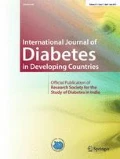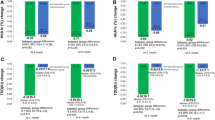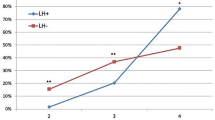Abstract
Aim
This study was aimed to assess the impact of ultrasound examination combined with intensive injection technique education for LH management.
Method
A total of 120 patients with diabetes who were identified as existing clinical LH were enrolled into the study. All patients underwent ultrasound examination and received intensive injection technique education based on ultrasound detection results and Chinese guideline for diabetic injection technology in a prospective single study in China with a follow-up of 3 months. Injection Technique Questionnaire (ITQ) and assessment of glycemic control were used to assess the impact of ultrasound examination combined with intensive injection technique education for LH management.
Results
As expected, after 3 months of intensive injection technique education based on ultrasound examination, the proportion of patients who had mastered insulin injection technique was significantly increased (p<0.05). The mean HbA1c was decreased by 0.60 (0.28)% from 7.61 (0.34)% to 7.01 (0.23)%, mean FBG was decreased by 1.20 (1.05) mmol/L from 8.10 (1.02) mmol/L to 6.90 (0.71) mmol/L, mean 2hPG was decreased by 1.70 (1.31) mmol/L from 11.49 (1.25) mmol/L to 9.79 (0.87) mmol/L without increasing the insulin dosage. The glycemic variability (GV) indicators (LAGE, MBG, SDBG, and PPGE), hypoglycemic, hyperglycemic, and IM injection events were markedly decreased (p<0.05).
Conclusions
Ultrasound examination combined with intensive injection technique education markedly improved glycemic control in diabetes with LH without increasing the insulin dosage, as well as reducing the occurrence of adverse blood glucose events. It can be a new effective approach for LH management.




Similar content being viewed by others
References
Landau S. Images in clinical medicine. Insulin-induced lipohypertrophy [J]. N Engl J Med. 2012;366(5):e9.
Grassi G, Scuntero P, Trepiccioni R, Marubbi F, Strauss K. Optimizing insulin injection technique and its effect on blood glucose control [J]. J Clin Transl Endocrinol. 2014;1(4):145–50.
Hauner H, Stockamp B, Haastert B. Prevalence of lipohypertrophy in insulin-treated diabetic patients and predisposing factors [J]. Exp Clin Endocrinol Diabetes. 1996;104(2):106–9.
Ji L, Sun Z, Li Q, Qin G, Wei Z, Liu J, et al. Lipohypertrophy in China: prevalence, risk factors, insulin consumption, and clinical impact [J]. Diabetes Technol Ther. 2017;19(1):61–7.
Tao L, Zhang X, Strauss K, Hirsch LJ, Chandran A. Estimated economic burden of insulin injection-related lipohypertrophy in Chinese patients with diabetes [J]. Value Health. 2014;17(7):A748–9.
Frid A, Gunnarsson R, Güntner P, et al. Effects of accidental intramuscular injection on insulin absorption in IDDM [J]. Diabetes Care. 1988;11(1):41–5.
Baron A, Kim D, Weyer C. Novel peptides under development for the treatment of type 1 and type 2 diabetes mellitus [J]. Curr Drug Targets Immune Endocr Metabol Disord. 2002;2(1):63–82.
Martinez L, Consoli S, Monnier L, et al. Studying the Hurdles of Insulin Prescription (SHIP): development, scoring and initial validation of a new self-administered questionnaire [J]. Health Qual Life Outcomes. 2007;5:53.
Ghazaleh HA, Hashem R, Forbes A, et al. A systematic review of ultrasound-detected lipohypertrophy in insulin-exposed people with diabetes [J]. Diabetes Ther. 2018;9(5):1741–56.
Volkova NI, Davidenko I, Rudakova J, et al. Insulin-induced lipohypertrophy diagnostics in diabetic patients: subcutaneous fat ultrasonography; proceedings of the 17th European Congress of Endocrinology, F, 2015 [C]. BioScientifica.
Ji L, Gou X, Huang J, et al. Chinese guideline for diabetic injection technology [J]. Chin J Diabetes Mellitus. 2017;9(2):79–105.
Song Z, Guo X, Ji L, et al. Insulin injection technique in China compared with the rest of the world [J]. Diabetes Ther. 2018;9(6):2357–68.
Vardar B, Kizilci S. Incidence of lipohypertrophy in diabetic patients and a study of influencing factors [J]. Diabetes Res Clin Pract. 2007;77(2):231–6.
Wang W, Guo X, Shen G, Bai G, Wei Z, Liu J, et al. Skin and subcutaneous tissue thickness at insulin injection sites in Chinese diabetes patients: Clinical implications [J]. Diabetes Metab. 2016;42(5):374–7.
Gupta S, Gupta K, Gathe S, et al. Clinical implications of lipohypertrophy among people with type 1 diabetes in India [J]. Diabetes Technol Ther. 2018;20(7):483–91.
Deeb A, Abdelrahman L, Tomy M, Suliman S, Akle M, Smith M, et al. Impact of insulin injection and infusion routines on lipohypertrophy and glycemic control in children and adults with diabetes [J]. Diabetes Ther. 2019;10(1):259–67.
Volkova NI, Davidenko IY. Clinical significance of lipohypertrophy without visual and palpable changes detected by ultrasonography of subcutaneous fat [J]. Ter Arkh. 2019;91(4):62–6.
Campinos C, Petit C, et al. An effective intervention for diabetic lipohypertrophy: results of a randomized, controlled, prospective multicenter study in France [J]. Diabetes Technol Ther. 2017;19(11):623–32.
Smith M, Clapham L, Strauss K. UK lipohypertrophy interventional study [J]. Diabetes Res Clin Pract. 2017;126:248–53.
Chen L, Xing Q, Jing LI, et al. 337-OR: Injection Technique (IT) Training in Subjects Injecting into Lipohypertrophy (LH)—The Tianjin Randomized Controlled Trial (RCT)[J]. Diabetes. 2019;68(Supplement 1):337-OR.
Ceriello A, Monnier L, Owens D. Glycaemic variability in diabetes: clinical and therapeutic implications [J]. Lancet Diabetes Endocrinol. 2019;7(3):221–30.
Famulla S, Hövelmann U, Fischer A, Coester HV, Hermanski L, Kaltheuner M, et al. Insulin injection into lipohypertrophic tissue: blunted and more variable insulin absorption and action and impaired postprandial glucose control [M]. Diabetes Care. 2016;39:1486–92.
Boon IS, Saeed MA. Cautionary tale: subdural haematoma following frequent hypoglycaemia from insulin-induced lipohypertrophy[J]. Bmj Case Reports. 2015;(2015):bcr2015212855.
Barola A, Tiwari P, Bhansali A. Insulin-mediated lipohypertrophy: an uncommon cause of diabetic ketoacidosis[J]. Bmj Case Reports. 2017;(2017):bcr-2017-220387.
Chowdhury TA, Escudier V. Poor glycaemic control caused by insulin induced lipohypertrophy [J]. BMJ (Clin Res Ed). 2003;327(7411):383–4.
Hsu C, Chen Y, Sheu W. Glycemic variability and diabetes retinopathy: a missing link [J]. J Diabetes Complicat. 2015;29(2):302–6.
Acknowledgments
We thank the department of ultrasonography of our hospital for providing the ultrasound equipment and technical support.
Author information
Authors and Affiliations
Corresponding authors
Ethics declarations
Ethical Statements
The study was approved by the Ethical Committee of First Hospital of Longyan. Written informed consent from each patient was waived.
Conflicts of interest
We declared that all authors have read and approved the manuscript and there is no conflict of interest existing in the submission of this manuscript, and the manuscript is approved by all authors for publication.
Additional information
Publisher’s note
Springer Nature remains neutral with regard to jurisdictional claims in published maps and institutional affiliations.
Supplementary Information
ESM 1
(DOCX 12 kb)
Rights and permissions
About this article
Cite this article
Wang, W., Tong, Y., Chen, Y. et al. Evaluation of ultrasound examination combined with intensive injection technique education on insulin-induced lipohypertrophy (LH) management: a prospective cohort study in China. Int J Diabetes Dev Ctries 41, 669–675 (2021). https://doi.org/10.1007/s13410-021-00935-7
Received:
Accepted:
Published:
Issue Date:
DOI: https://doi.org/10.1007/s13410-021-00935-7




